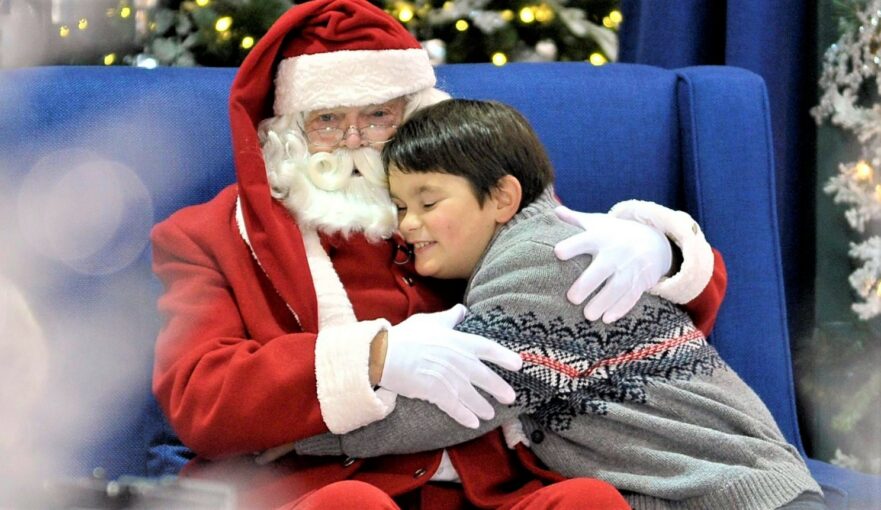I fondly remember Christmas time with our children Heather and Josh. Heather handled “finding out the truth” about Santa relatively naturally but once Josh turned around 7 years of age, he would constantly ask me straight out if there was a Santa Claus. I was on the spot- do I keep the gentle lie about Santa going, or do I tell him Santa is not a real person and destroy his 7-year-old innocence and belief about Santa?
Every time he would push the question, I would gently ask him what he thought or what he heard about Santa. I was often tempted to explain to him the Santa myth. But instead, each year I followed his lead on his level of interest in believing or not about Santa. At this age he still wanted to sit on Santa’s lap, the real Santa that is, the one at the mall with the best decorations, not those impostors who showed up at various places. At that age he also delighted in waking up on Christmas morning and finding the milk and cookies that he left for Santa gone and replaced with a handwritten note to him from the jolly old man in the Red Suit.
My recollections of how my children reacted to finding out the truth about Santa are not unique. It’s going to happen to every parent who has ever introduced their children to the wonders of Santa Claus. When that dreaded day arrives and your child asks, “Is Santa Claus Real?” – What do you say?
There’s no clear right time to tell children that there is no Santa Claus. The average age for children to separate from the Santa myth is 8.4 years of age. Some children will learn that Santa is not real from an older sibling or friend from school, some simply give up the fantasy earlier and some children will hold onto Santa Claus as real for a few years longer. The important thing is to take your cues from your child, and not try to prolong the fantasy for your own enjoyment when they may be developmentally ready to give it up.
For many children, finding out, or coming to realize that there is no Santa Claus, is often one of the very first developmental loses that they will have to deal with experientially. Developmental loss is experienced by the child just like any person or object loss that an adult might experience and feel. Children unfortunately are less life experienced and emotionally mature to deal with loss. Some children will hold their loss in and keep it internal- some will act it out- and others will just move on naturally to the next developmental issue they will face.
When some children stop believing in Santa, they may feel betrayed, angry, or lied to by their parents. It matters very much how parents have presented Santa. There are many opinions on the merits or the disadvantages of deliberately involving children in a myth parents know not to be true. Some parents hedge the myth a bit and represent the Santa figure more as the spirit of giving, so that all giving has a little bit of Santa in it.
Usually when children stop believing in Santa as a physical being, viewing Santa more as imaginative play or as a symbol of giving- the child’s failure to believe or figuring it out doesn’t hit as hard emotionally. Other children, who really have a solid and concrete image in their mind of Santa as a real being may be absolutely devastated when this belief is taken from them. Yet others feel may feel smart they figured the Santa myth out on their own.
The age at which children stop believing in Santa is variable and depends much on the way the stories of Santa Claus are presented (if they are in fact presented) in the home. Some children are told the basics of the myth, that Santa is real, comes to their homes on Christmas night, rewards good behavior and punishes bad, and has many magical attributes. When this is the primary teaching many children stop believing in Santa at around the age of eight or nine, though this will vary.
As a child’s brain grows, and as they gain some life experience, they begin to acquire a certain amount of logic and reasoning skills. At this point they may begin to figure it out on their own or start to question the existence of Santa when they see presents in the closet before Christmas or note that all gifts are addressed in Mom or Dad’s handwriting.
Peer relationships also cause speculation, since children will encounter other children who don’t believe, or who have already been told the “truth.” Some children stop believing in Santa when assured by another child he doesn’t exist. Alternately, as they grow older and socialize in school with other children, they may notice Santa is not universal as they acquire friends who don’t celebrate Christmas. They might also note the disparity between the gifts they receive and those received by friends with parents on different budgets.
The best rule of thumb is to follow the child’s lead in this regard. Ask what the child believes. Just because your child is asking questions doesn’t necessarily mean that he or she is emotionally ready to believe the truth. Asking, “Well, what do you think?” will give you an idea of where the child is both emotionally and cognitively. If the child still believes in Santa, despite any outside doubts, it’s not time yet.
Naturally, parents want to avoid causing unnecessary pain when children stop believing in Santa, so presentation of Santa is important. Presentation may run contrary to the many Christmas movies and Christmas cartoons that assert and reassert Santa’s existence, so you must weigh carefully which of these to allow, and what discussions could take place around this issue.
It’s also a good idea to be somewhat noncommittal on the issue of a real Santa Claus instead of committing a full lie. Allow children to tell you what they believe and let them hold onto their belief if they’d like. As they age, and usually before they hit their preteens, they may have figured out Santa as it best works for them. You might tell them everybody needs to decide personally, what, and how to believe.
There are some children (and adults) who never stop believing, especially when they view Santa as the spirit of Christmas, and an extension of some of the religious or cultural expressions of Christmas. People with this view get to be Santa and contribute to the spirit of Santa through their kind and generous actions. When children stop believing in Santa and express disillusion in the myth, you might consider teaching them how to play Santa and be Santa in their own generous actions. Enlist them in charitable work, like picking out or distributing toys to children who are impoverished and share with them the joy of getting to act like Santa during the holidays and throughout the year.
In summary, above all be sensitive to the fact that some children will experience the realization of the Santa myth as loss and may feel emotional pain or minor depression in relation to that loss. Others may act it out and blame their parents for lying to them. Others still may transition without any difficulty in finding out that Santa is not a real person as they had thought or believed.
In all cases try to focus your child on the spirit of giving, of the family support and closeness and hope that Christmas and the Holidays affords us all at this time of year. The Santa story can be a wonderful experience for you and your child…I think there is something profoundly beautiful about the way the world is seen through the eyes of a child at this time of year. They truly see the magic that the season offers us through the joy and hope they experience as they await Christmas.
You could also do what we did after explaining that there was no Santa and helping Josh figure it out and come to accept that fact- Mom and Dad believe that there’s no proof that he isn’t real and during the Christmas Season “BELIEVE” remains the mantra of our household!
I wish you and your families a holiday season full of joy and peace along with the thrill of hope as our weary world rejoices and celebrates. Be well, joe cozzo




